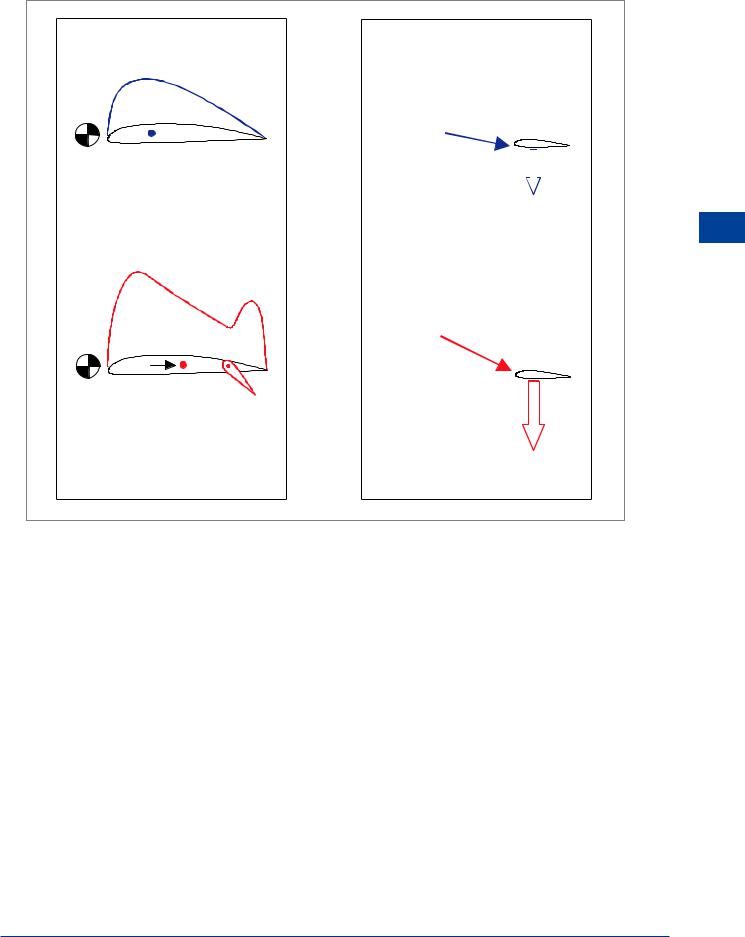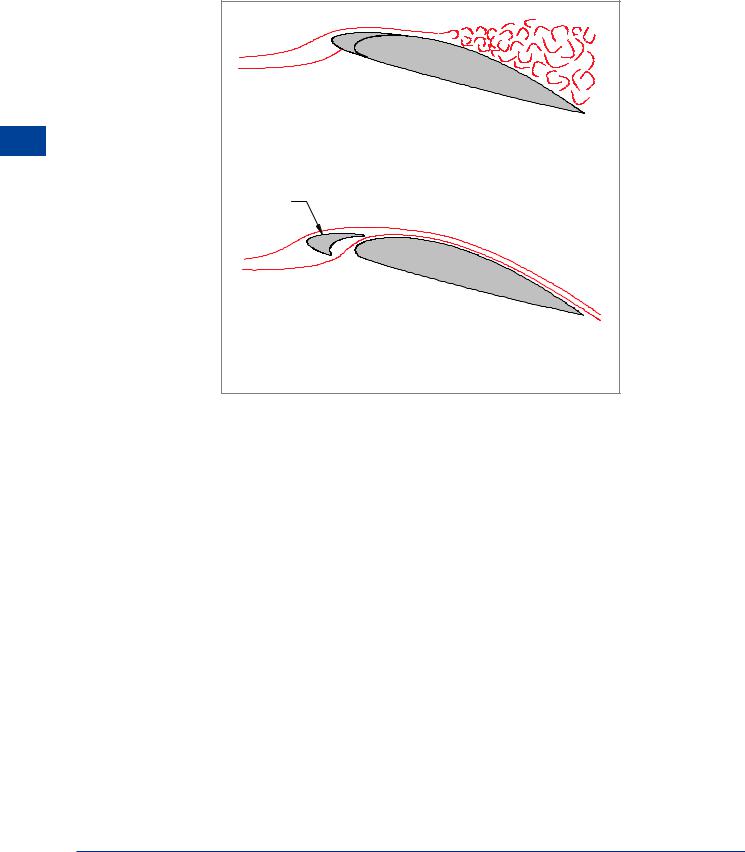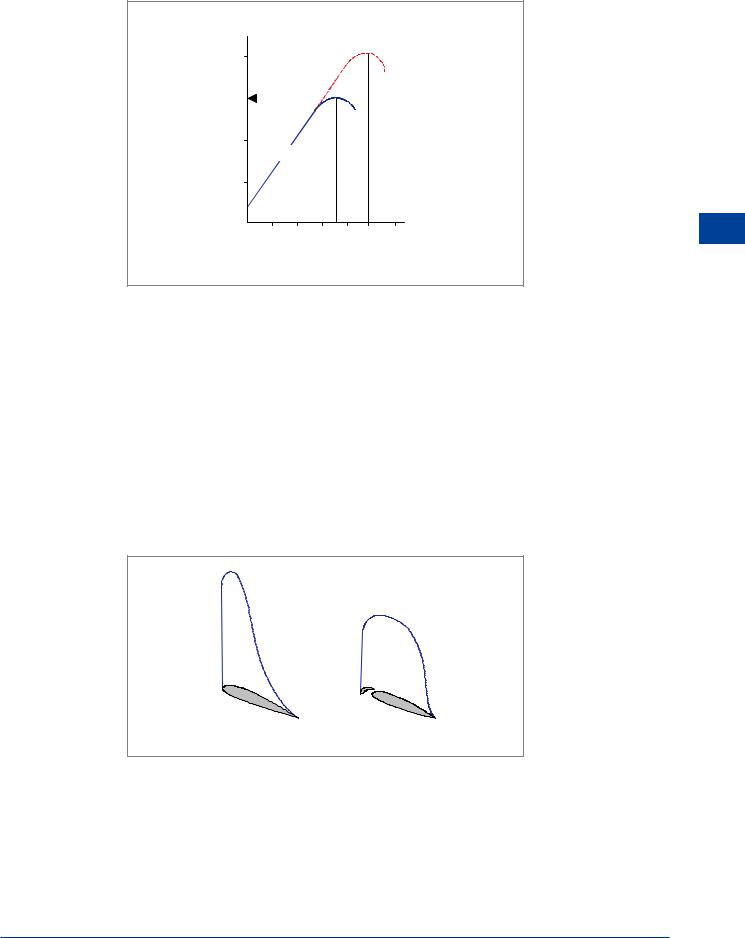
- •Textbook Series
- •Contents
- •1 Overview and Definitions
- •Overview
- •General Definitions
- •Glossary
- •List of Symbols
- •Greek Symbols
- •Others
- •Self-assessment Questions
- •Answers
- •2 The Atmosphere
- •Introduction
- •The Physical Properties of Air
- •Static Pressure
- •Temperature
- •Air Density
- •International Standard Atmosphere (ISA)
- •Dynamic Pressure
- •Key Facts
- •Measuring Dynamic Pressure
- •Relationships between Airspeeds
- •Airspeed
- •Errors and Corrections
- •V Speeds
- •Summary
- •Questions
- •Answers
- •3 Basic Aerodynamic Theory
- •The Principle of Continuity
- •Bernoulli’s Theorem
- •Streamlines and the Streamtube
- •Summary
- •Questions
- •Answers
- •4 Subsonic Airflow
- •Aerofoil Terminology
- •Basics about Airflow
- •Two Dimensional Airflow
- •Summary
- •Questions
- •Answers
- •5 Lift
- •Aerodynamic Force Coefficient
- •The Basic Lift Equation
- •Review:
- •The Lift Curve
- •Interpretation of the Lift Curve
- •Density Altitude
- •Aerofoil Section Lift Characteristics
- •Introduction to Drag Characteristics
- •Lift/Drag Ratio
- •Effect of Aircraft Weight on Minimum Flight Speed
- •Condition of the Surface
- •Flight at High Lift Conditions
- •Three Dimensional Airflow
- •Wing Terminology
- •Wing Tip Vortices
- •Wake Turbulence: (Ref: AIC P 072/2010)
- •Ground Effect
- •Conclusion
- •Summary
- •Answers from page 77
- •Answers from page 78
- •Questions
- •Answers
- •6 Drag
- •Introduction
- •Parasite Drag
- •Induced Drag
- •Methods of Reducing Induced Drag
- •Effect of Lift on Parasite Drag
- •Aeroplane Total Drag
- •The Effect of Aircraft Gross Weight on Total Drag
- •The Effect of Altitude on Total Drag
- •The Effect of Configuration on Total Drag
- •Speed Stability
- •Power Required (Introduction)
- •Summary
- •Questions
- •Annex C
- •Answers
- •7 Stalling
- •Introduction
- •Cause of the Stall
- •The Lift Curve
- •Stall Recovery
- •Aircraft Behaviour Close to the Stall
- •Use of Flight Controls Close to the Stall
- •Stall Recognition
- •Stall Speed
- •Stall Warning
- •Artificial Stall Warning Devices
- •Basic Stall Requirements (EASA and FAR)
- •Wing Design Characteristics
- •The Effect of Aerofoil Section
- •The Effect of Wing Planform
- •Key Facts 1
- •Super Stall (Deep Stall)
- •Factors that Affect Stall Speed
- •1g Stall Speed
- •Effect of Weight Change on Stall Speed
- •Composition and Resolution of Forces
- •Using Trigonometry to Resolve Forces
- •Lift Increase in a Level Turn
- •Effect of Load Factor on Stall Speed
- •Effect of High Lift Devices on Stall Speed
- •Effect of CG Position on Stall Speed
- •Effect of Landing Gear on the Stall Speed
- •Effect of Engine Power on Stall Speed
- •Effect of Mach Number (Compressibility) on Stall Speed
- •Effect of Wing Contamination on Stall Speed
- •Warning to the Pilot of Icing-induced Stalls
- •Stabilizer Stall Due to Ice
- •Effect of Heavy Rain on Stall Speed
- •Stall and Recovery Characteristics of Canards
- •Spinning
- •Primary Causes of a Spin
- •Phases of a Spin
- •The Effect of Mass and Balance on Spins
- •Spin Recovery
- •Special Phenomena of Stall
- •High Speed Buffet (Shock Stall)
- •Answers to Questions on Page 173
- •Key Facts 2
- •Questions
- •Key Facts 1 (Completed)
- •Key Facts 2 (Completed)
- •Answers
- •8 High Lift Devices
- •Purpose of High Lift Devices
- •Take-off and Landing Speeds
- •Augmentation
- •Flaps
- •Trailing Edge Flaps
- •Plain Flap
- •Split Flap
- •Slotted and Multiple Slotted Flaps
- •The Fowler Flap
- •Comparison of Trailing Edge Flaps
- •and Stalling Angle
- •Drag
- •Lift / Drag Ratio
- •Pitching Moment
- •Centre of Pressure Movement
- •Change of Downwash
- •Overall Pitch Change
- •Aircraft Attitude with Flaps Lowered
- •Leading Edge High Lift Devices
- •Leading Edge Flaps
- •Effect of Leading Edge Flaps on Lift
- •Leading Edge Slots
- •Leading Edge Slat
- •Automatic Slots
- •Disadvantages of the Slot
- •Drag and Pitching Moment of Leading Edge Devices
- •Trailing Edge Plus Leading Edge Devices
- •Sequence of Operation
- •Asymmetry of High Lift Devices
- •Flap Load Relief System
- •Choice of Flap Setting for Take-off, Climb and Landing
- •Management of High Lift Devices
- •Flap Extension Prior to Landing
- •Questions
- •Annexes
- •Answers
- •9 Airframe Contamination
- •Introduction
- •Types of Contamination
- •Effect of Frost and Ice on the Aircraft
- •Effect on Instruments
- •Effect on Controls
- •Water Contamination
- •Airframe Aging
- •Questions
- •Answers
- •10 Stability and Control
- •Introduction
- •Static Stability
- •Aeroplane Reference Axes
- •Static Longitudinal Stability
- •Neutral Point
- •Static Margin
- •Trim and Controllability
- •Key Facts 1
- •Graphic Presentation of Static Longitudinal Stability
- •Contribution of the Component Surfaces
- •Power-off Stability
- •Effect of CG Position
- •Power Effects
- •High Lift Devices
- •Control Force Stability
- •Manoeuvre Stability
- •Stick Force Per ‘g’
- •Tailoring Control Forces
- •Longitudinal Control
- •Manoeuvring Control Requirement
- •Take-off Control Requirement
- •Landing Control Requirement
- •Dynamic Stability
- •Longitudinal Dynamic Stability
- •Long Period Oscillation (Phugoid)
- •Short Period Oscillation
- •Directional Stability and Control
- •Sideslip Angle
- •Static Directional Stability
- •Contribution of the Aeroplane Components.
- •Lateral Stability and Control
- •Static Lateral Stability
- •Contribution of the Aeroplane Components
- •Lateral Dynamic Effects
- •Spiral Divergence
- •Dutch Roll
- •Pilot Induced Oscillation (PIO)
- •High Mach Numbers
- •Mach Trim
- •Key Facts 2
- •Summary
- •Questions
- •Key Facts 1 (Completed)
- •Key Facts 2 (Completed)
- •Answers
- •11 Controls
- •Introduction
- •Hinge Moments
- •Control Balancing
- •Mass Balance
- •Longitudinal Control
- •Lateral Control
- •Speed Brakes
- •Directional Control
- •Secondary Effects of Controls
- •Trimming
- •Questions
- •Answers
- •12 Flight Mechanics
- •Introduction
- •Straight Horizontal Steady Flight
- •Tailplane and Elevator
- •Balance of Forces
- •Straight Steady Climb
- •Climb Angle
- •Effect of Weight, Altitude and Temperature.
- •Power-on Descent
- •Emergency Descent
- •Glide
- •Rate of Descent in the Glide
- •Turning
- •Flight with Asymmetric Thrust
- •Summary of Minimum Control Speeds
- •Questions
- •Answers
- •13 High Speed Flight
- •Introduction
- •Speed of Sound
- •Mach Number
- •Effect on Mach Number of Climbing at a Constant IAS
- •Variation of TAS with Altitude at a Constant Mach Number
- •Influence of Temperature on Mach Number at a Constant Flight Level and IAS
- •Subdivisions of Aerodynamic Flow
- •Propagation of Pressure Waves
- •Normal Shock Waves
- •Critical Mach Number
- •Pressure Distribution at Transonic Mach Numbers
- •Properties of a Normal Shock Wave
- •Oblique Shock Waves
- •Effects of Shock Wave Formation
- •Buffet
- •Factors Which Affect the Buffet Boundaries
- •The Buffet Margin
- •Use of the Buffet Onset Chart
- •Delaying or Reducing the Effects of Compressibility
- •Aerodynamic Heating
- •Mach Angle
- •Mach Cone
- •Area (Zone) of Influence
- •Bow Wave
- •Expansion Waves
- •Sonic Bang
- •Methods of Improving Control at Transonic Speeds
- •Questions
- •Answers
- •14 Limitations
- •Operating Limit Speeds
- •Loads and Safety Factors
- •Loads on the Structure
- •Load Factor
- •Boundary
- •Design Manoeuvring Speed, V
- •Effect of Altitude on V
- •Effect of Aircraft Weight on V
- •Design Cruising Speed V
- •Design Dive Speed V
- •Negative Load Factors
- •The Negative Stall
- •Manoeuvre Boundaries
- •Operational Speed Limits
- •Gust Loads
- •Effect of a Vertical Gust on the Load Factor
- •Effect of the Gust on Stalling
- •Operational Rough-air Speed (V
- •Landing Gear Speed Limitations
- •Flap Speed Limit
- •Aeroelasticity (Aeroelastic Coupling)
- •Flutter
- •Control Surface Flutter
- •Aileron Reversal
- •Questions
- •Answers
- •15 Windshear
- •Introduction (Ref: AIC 84/2008)
- •Microburst
- •Windshear Encounter during Approach
- •Effects of Windshear
- •“Typical” Recovery from Windshear
- •Windshear Reporting
- •Visual Clues
- •Conclusions
- •Questions
- •Answers
- •16 Propellers
- •Introduction
- •Definitions
- •Aerodynamic Forces on the Propeller
- •Thrust
- •Centrifugal Twisting Moment (CTM)
- •Propeller Efficiency
- •Variable Pitch Propellers
- •Power Absorption
- •Moments and Forces Generated by a Propeller
- •Effect of Atmospheric Conditions
- •Questions
- •Answers
- •17 Revision Questions
- •Questions
- •Answers
- •Explanations to Specimen Questions
- •Specimen Examination Paper
- •Answers to Specimen Exam Paper
- •Explanations to Specimen Exam Paper
- •18 Index

High Lift Devices |
|
8 |
|
||
|
|
|
WING |
TAILPLANE |
|
CP |
DOWNWASH |
|
|
|
|
|
|
8 |
|
INCREASED |
High Lift Devices |
|
|
|
|
DOWNWASH |
|
CP |
|
|
NOSE-DOWN |
NOSE-UP |
|
PITCHING MOMENT |
PITCHING MOMENT |
|
Figure 8.10
(a) |
(b) |
Overall Pitch Change
The resultant aircraft pitching moment will depend upon which of the two effects is dominant. The pitching moment will be influenced by the type of flap, the position of the wing and the relative position of the tailplane, and may be nose-up, nose-down or almost zero. For example, on flap extension, a tailplane mounted on top of the fin will be less influenced by the change of downwash, resulting in an increased aircraft nose-down pitching moment.
Aircraft Attitude with Flaps Lowered
When the aircraft is in steady flight the lift must be equal to the weight. If the flaps are lowered but the speed kept constant, lift will increase, and to maintain it at its original value, the angle of attack must be decreased. The aircraft will therefore fly in a more nose-down attitude if the flaps are down. On the approach to landing this is an advantage as it gives better visibility of the landing area.
215

8 High Lift Devices
Leading Edge High Lift Devices
There are two forms of leading edge high lift device commonly in use: the leading edge flap and the leading edge slot or slat.
Leading Edge Flaps
On high speed aerofoil sections the leading edge may have very little camber and have a small radius. This can give flow separation just aft of the leading edge at quite low angles of attack. This can be remedied by utilizing a leading edge flap, which increases the leading edge camber.
Devices Lift High 8
Figure 8.11 Krueger flap
Krueger Flap
The Krueger flap is part of the lower surface of the leading edge, which can be rotated about its forward edge as shown in Figure 8.11. To promote root stall on a swept wing, Krueger flaps are used on the inboard section because they are less efficient than the variable camber shown opposite.
216

High Lift Devices |
|
8 |
|
||
|
|
|
RETRACTED
EXTENDED
Figure 8.12 Variable camber leading edge flap
Variable Camber Leading Edge Flap
To improve efficiency by giving a better leading edge profile, the camber of a leading edge flap may be increased as it is deployed. Unlike trailing edge flaps, which can be selected to intermediate positions, leading edge flaps are usually either fully extended (deployed) or retracted (stowed).
Effect of Leading Edge Flaps on Lift
The main effect of the leading edge flap is to delay separation and so increase the stalling angle and the corresponding CLMAX. However, there will be some increase of lift at lower angles of attack due to the increased camber of the aerofoil section. Figure 8.13 shows the effect of these flaps on the lift curve.
WITH LEADING EDGE FLAP |
CL |
BASIC WING SECTION |
Figure 8.13
High Lift Devices 8
217

8 |
|
High Lift Devices |
|
||
|
|
|
Leading Edge Slots
A leading edge slot is a gap from the lower surface to the upper surface of the leading edge, and it may be fixed, or created by moving part of the leading edge (the slat) forwards.
8 |
CLMAX WING |
(Given Adverse Pressure Gradient) |
Lift High |
SLAT |
|
Devices |
|
|
|
|
|
|
SLAT OPEN - Boundary Layer Re - energized |
|
|
(Same Adverse Pressure Gradient) |
|
Figure 8.14 Leading edge slat
Leading Edge Slat
A slat is a small auxiliary aerofoil attached to the leading edge of the wing, Figure 8.14. When deployed, the slat forms a slot which allows passage of air from the high pressure region below the wing to the low pressure region above it. Additional Kinetic Energy is added to the airflow through the slot by the slat forming a convergent duct.
When slats are deployed, the boundary layer is re-energized
If Kinetic Energy is added to the boundary layer, boundary layer separation will be delayed to a much higher angle of attack. At approximately 25°, the increased adverse pressure gradient will once again overwhelm the Kinetic Energy of the boundary layer and separation will occur.
If the slot is permanently open, i.e. a fixed slot, the extra drag at high speed is an unnecessary disadvantage, so most slats in commercial use are opened and closed by a control mechanism.
The slot can be closed for high speed flight and opened for low speeds, usually in conjunction with the trailing edge flaps and actuated by the same selector on the flight deck.
The graph at Figure 8.15 shows the comparative figures for a slatted and un-slatted wing of the same basic dimensions.
218

High Lift Devices |
|
8 |
|
||
|
|
|
2.0 |
|
|
|
WING PLUS |
|
|
|
SLATS |
|
C L |
|
|
|
|
1.5 |
|
CLMAX |
|
|
|
|
1.0
WING
0.5
5 |
10 |
15 |
20 |
25 |
30 |
Angle of Attack
Figure 8.15
The effect of the slat is to prolong the lift curve by delaying boundary layer separation until a higher angle of attack. When operating at high angles of attack, the slat itself is generating a high lift coefficient because of its marked camber. The action of the slat is to flatten the marked peak of the low pressure envelope at high angles of attack and to change it to one with a more gradual pressure gradient. The flattening of the lift distribution envelope means that the boundary layer does not undergo the sudden thickening that occurred through having to negotiate the very steep adverse pressure gradient that existed immediately behind the former ‘suction’ peak, and so it retains much of its Kinetic Energy, thus enabling it to penetrate almost the full chord of the wing before separating. Figure 8.16 shows the alleviating effect of the slat on the low pressure peak and that, although flatter, the area of the low pressure region, which is proportional to its strength, is unchanged or even increased. The ‘suction’ peak does not move forward, so the effect of the slot on pitching moment is insignificant.
High Lift Devices 8
No Slat |
With Slat |
Figure 8.16
219
